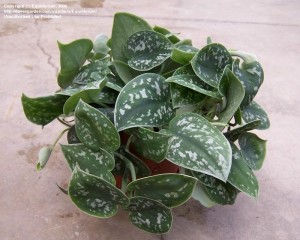What’s Wrong With My Plant- Can You Identify My Plant?
Hi Judy,
I have had this plant for a few years. It was a gift and I’m not sure what it’s called. It has some spotting on the heart shaped leaves. It has always been easy to take care of but recently it seems to be dying and I’ve tried everything… Watering, not watering, trimming, I even repotted it just in case. All the leaves have curled in lengthwise and everyday about 4 or 5 are turning yellow and falling off… They are all limp feeling. I’m even losing a lot of the bigger leaves. I have switched the rooms to give it less sun or more sun and I’m out of ideas, please help!!
Hi,
You plant is a type of philodendron and has several names: satin pothos, silver philodendron, or the scientific name, Scindapsus pictus argyraeus. Here is what a healthy one looks like.

Satin Pothos
It looks like the roots of your plant are dying from being kept too wet. Take the plant out of the pot and examine the roots. Cut off any roots that are dead or mushy and don’t appear healthy. allow the plant to sit out bare root over night. Re-pot in fresh soil. Use a container that is only an inch or two larger than the root ball. Be sure there are drip holes in the bottom of the container so excess water can drain out. Place in bright, indirect light.
Do not fertilize until the plant starts producing new leaves and always reduce the plant food to 1/2 the recommended strength. Feed the plant every two weeks in the spring and summer and monthly in the fall and winter.
You can read all my plant care tips for Pothos Plants in the Popular HousePlant section of the website. The picture is of a different type of pothos but the care is the same.
https://www.houseplant411.com/houseplant/pothos-plant-care-tips
These plants are considered poisonous and should be kept away from pets and children. Read more about common houseplants that are poisonous in Don’t Feed Me To Your Cat! A Guide to Poisonous Houseplants.
This is what a healthy satin pothos looks like.
